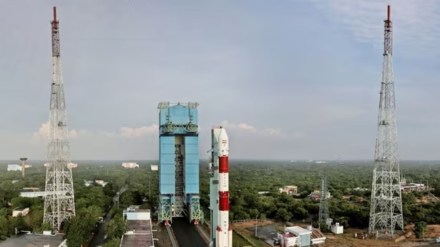The Indian Space Research Organisation (ISRO) began a revised 8.5-hour countdown on Thursday (December 5) for the launch of the European Space Agency’s (ESA) Proba-3 mission. Originally scheduled for 4:08 PM on Wednesday, the launch from the spaceport was postponed at the request of ESA. The new launch time for PSLV-C59/PROBA-3 is set for 4:04 PM on December 5.
The launch of ISRO’s PSLV rocket was postponed on Wednesday just minutes before liftoff due to an “anomaly” detected in the Proba-3 satellites, which were to be carried aboard the rocket.
Countdown begins for historic mission
The Proba-3 mission is being conducted under the commercial arm of ISRO, NewSpace India Ltd (NSIL), which has secured the contract from the ESA. This mission will be the 61st flight of ISRO’s trusted Polar Satellite Launch Vehicle (PSLV), specifically the PSLV-XL variant, which is known for its heavy-lift capabilities.
The mission will carry two spacecraft, the Coronagraph and the Occulter, that are designed to fly in a highly precise formation to study the Sun’s outer atmosphere. The unique formation-flying technology used in this mission will pave the way for future space exploration efforts.
Proba-3: A first-of-its-kind space mission
Proba-3, short for “Project for Onboard Autonomy,” is a pioneering mission that aims to demonstrate the ability of two spacecraft to fly together as a single, integrated unit in space, maintaining formation down to the millimeter level. The two spacecraft will operate in tandem to create a solar coronagraph, a tool that will enable scientists to study the Sun’s corona—the outermost layer of its atmosphere—in unprecedented detail.
The term Proba is derived from the Latin word meaning “Let’s try,” reflecting the mission’s goal of pushing the boundaries of space technology and scientific observation. The two spacecraft—Coronagraph and Occulter—will be launched in a stacked configuration aboard the PSLV rocket.
Mission objectives and scientific goals
The primary objective of the Proba-3 mission is to demonstrate formation flying with high precision. The Occulter spacecraft will block out the solar disk, allowing the Coronagraph to observe the Sun’s corona. This type of formation-flying has typically only been possible during brief solar eclipses, but with Proba-3, ESA scientists hope to create “solar eclipses on demand” for extended periods.
The corona, which is much hotter than the Sun itself, is a crucial area of study for understanding space weather, solar activity, and the Sun’s influence on Earth. Proba-3 will allow scientists to study the solar corona closer to the solar rim than ever before, providing valuable data for space weather prediction and other solar phenomena.
As ESA explained, “The corona is where space weather originates, and it has been a topic of widespread scientific and practical interest. Proba-3 will allow us to study it in a way that has never been possible before.”
ISRO’s tole in the mission
While the European Space Agency will lead the scientific aspects of the Proba-3 mission, ISRO’s involvement is critical to the success of the launch. ISRO will provide the PSLV-XL rocket, known for its reliability and capacity to carry payloads of up to 500 kg to orbit, as well as oversee the satellite’s deployment into its designated orbit.
For ISRO, this launch comes shortly after the successful deployment of its own solar observation mission, Aditya-L1, which was launched in September 2023. The Proba-3 mission will further bolster ISRO’s expertise in solar science, particularly in the realm of space weather and solar research.
The launch vehicle: PSLV-XL
The PSLV-XL rocket, standing 44.5 meters tall, will carry the Proba-3 satellites into orbit. The launch vehicle is known for its versatility and success in carrying out a variety of missions, from earth observation satellites to interplanetary missions. This will be the 26th flight of the PSLV-XL variant, which is known for its larger payload capacity.
After the lift-off, the PSLV-XL will travel for approximately 18 minutes before placing the 550 kg Proba-3 spacecraft into a highly elliptical orbit, with an apogee of 60,530 km and a perigee of 600 km. The satellites will then separate and begin their formation flying, maintaining a distance of 150 meters between them in space. This precise formation is critical for the scientific goals of the mission.
Significance and importance of Proba-3 mission
The Proba-3 mission is not only a significant step for ESA but also a showcase of ISRO’s growing capabilities in the global space arena. ISRO’s collaboration with the European Space Agency in this mission highlights the increasing role of commercial arms like NewSpace India Ltd in international space endeavors.
The Proba-3 mission follows in the footsteps of previous Proba missions launched by ESA, such as Proba-1 (2001) and Proba-2 (2009), but it marks the first time that such formation-flying technology will be tested in space for an extended period.
With the successful deployment of the Proba-3 spacecraft, scientists will gain insights into space weather phenomena and open new doors for the study of the Sun. This mission is expected to be a cornerstone for future space exploration technologies, providing vital data that could one day influence our understanding of not just the Sun, but also space weather systems that impact satellite communication, navigation, and even Earth’s climate.
